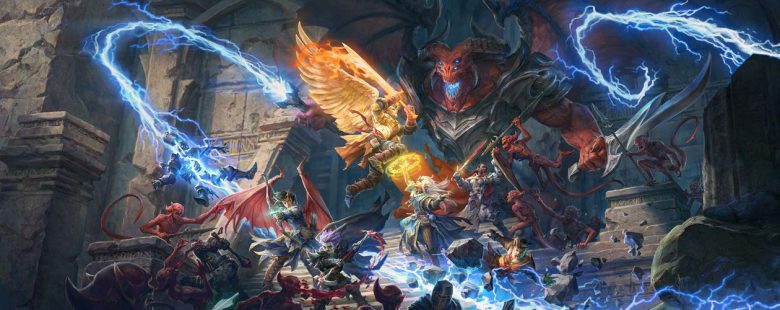The resurgence of the cRPG over the past decade has been a source of great delight for fans of the genre’s heyday, seeing renowned developers return to their old stomping grounds. For newcomers, it could have been an uphill struggle to get noticed amongst the big names and the return of classic CRPGs, but Owlcat Games managed to carve out a niche for themselves, adapting the Pathfinder Roleplaying Game into Pathfinder: Kingmaker.
While it drew a fair amount of praise, it was also a major learning experience for the team, having shipped with far too many bugs in particular. Now, with the hard-earned experience of that game to draw from, Owlcat are returning to Kickstarter with Pathfinder: Wrath of the Righteous.
The goals for Wrath of the Righteous as a new Pathfinder game is pretty simple: be more epic, be thematically darker than Kingmaker, and make some mechanical changes here and there to simply be a better game. Oh, and just be more polished in general. In particular, one thing that players weren’t so fond of in Kingmaker was the time pressure that was attached to your kingdom management, and so Owlcat have tried to capture a similar narrative tension in a different way.
This isn’t a direct sequel to that game, but set at another point in the fantasy world’s history, with a huge war between the invading demons and paladins trying to fend them off. While that might appear to be a classic case of good and evil, there aren’t those kinds of absolutes. Demons can be as war weary and disaffected with their side’s actions as the erstwhile heroes can be bloodthirsty maniacs or use dark magics to get ahead. One of the themes running through the game is that of corruption and redemption, the cost of power and the lengths that you’re willing to go to.
The opening has us fighting to recapture the fortified city of Drezen, reclaiming it from the demons who have ruled there for years. I say it’s the opening, but the actual assault on Drezen is still at the end of the game’s second chapter and a good 20 hours into the game.

By this point you will have assembled a group of heroes to go into battle alongside you and advise you, and this comes into play as you plan your assault. Where Kingmaker had you ruling a kingdom, this has evolved into the Crusade Commander feature, where you oversee an army, recruiting and upgrading them, capturing strategic points in the world, and more. You’ll still be fighting as well, but can choose an angle of attack that’s presented to you.
For the assault on Drezen, your team of advisors presents you with several options, to simply assault the front gate, to attack a weak point in the wall and aim to kill giants that are acting as demonic artillery, or perhaps to try and sneak through some dungeons and get in behind the demonic battle lines.
You’re receiving these suggestions from a bunch of atypical characters, each with their own particular standing in the balance between good and bad. Regill, for example, is a part of the devils knight order, while Irabeth’s personal struggle makes her broken on the inside. There’s ten possible companions that you can recruit through the game, and as you’d expect, your decisions affect your relationships with them as you progress.
Of the options available, I chose for the sneakier approach, to head underneath the city walls and burst out into the unsuspecting demon defenders while my army attacked the front gates. Unfortunately, things weren’t quite as straightforward as I’d hoped; we were betrayed and an ambush awaited us.

Combat builds on that of Kingmaker, with all the complexity of a CRPG laid bare for you to explore. There’s different character classes and roles, the ability to set formations, set certain attacks to happen automatically or micromanage the battle through pausing the action, and so on.
Thankfully Owlcat have heard the anguished cries of all those who ran into a brick wall of difficulty in their previous game. Before they patched and rebalanced the game, they found that players were simply picking a difficulty too high for their ability or desires. You now have Normal as the base difficulty, followed by Daring, Core and Hard, hopefully helping to set those initial expectations for players, but you can also dive in and fiddle with various sliders – great for a brief demo and play session, as I was having. This allowed me to breeze through combat, making the game dramatically more accessible for those who might want to focus more on the story, characters and decisions than fraught CRPG battles that will kick your behind.
A part of who your character becomes will depend on the enhanced Mythic Paths system that aims to go beyond what was found in Kingmaker. Owlcat games are completely redoing the system, offering some new character types as well as rebalancing some of those that were basically just broken in the original tabletop game. This depends on how successful the game’s Kickstarter ends up being, but seven are planned, including become a demon yourself, forgoing this mortal coil to become a lich and raise an undead army with which to wage your war, or perhaps an Aion, a kind of supernatural Judge Dredd that’s able to see someone’s guilt and pass judgement there and then.
There’s a long way for Pathfinder: Wrath of the Righteous to go between now and release. For one thing, its Kickstarter has only just gone live today and Owlcat aren’t expecting to launch the game until the first half of 2021, but everything they’ve said about the project feels encouraging, whether you were a fan of the original or bounced off its troubled initial launch.


